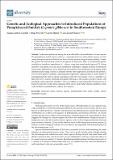Por favor, use este identificador para citar o enlazar a este item:
http://hdl.handle.net/10261/336495COMPARTIR / EXPORTAR:
 SHARE SHARE
 CORE
BASE CORE
BASE
|
|
| Visualizar otros formatos: MARC | Dublin Core | RDF | ORE | MODS | METS | DIDL | DATACITE | |

| Título: | Genetic and Ecological Approaches to Introduced Populations of Pumpkinseed Sunfish (Lepomis gibbosus) in Southwestern Europe |
Autor: | Lambea-Camblor, Ángela; Morcillo Alonso, Felipe CSIC ORCID CVN; Muñoz Fuente, Jesús CSIC ORCID ; Perdices, Anabel CSIC ORCID | Palabras clave: | Freshwater fishes Invasive species Mitochondrial DNA Niche overlap Species distribution models |
Fecha de publicación: | 2-oct-2023 | Editor: | Multidisciplinary Digital Publishing Institute | Citación: | Diversity 15(10): 1059 (2023) | Resumen: | Freshwater systems are among the most affected by the introduction of exotic species. The pumpkinseed sunfish Lepomis gibbosus, a centrarchid native to eastern North America, is listed among the top ten introduced freshwater fishes with the greatest ecological impact globally. Despite this, genetic and evolutionary studies of the species are still scarce. Here, we analyzed the genetic variability of introduced populations of L. gibbosus using three mitochondrial genes (COI, d-loop, and ND1). In addition, we used species distribution modeling to compare the niche of introduced versus native populations to assess the present and potential future distribution of the species under different climate change scenarios. Compared with the native populations, introduced ones present a lower level of genetic variability, indicating these populations originated from a small number of individuals from the native (Atlantic) population in the USA and Canada. The low variability was likely driven by a founder effect and subsequent bottleneck, as often occurs in invasive species. Our modeling results suggest not only that L. gibbosus modified its niche during the invasion process in Europe but also the possible global expansion of the species under future climatic conditions, which could facilitate its establishment in almost all continents. | Versión del editor: | https://doi.org/10.3390/d15101059 | URI: | http://hdl.handle.net/10261/336495 | DOI: | 10.3390/d15101059 | E-ISSN: | 1424-2818 |
| Aparece en las colecciones: | (MNCN) Artículos (RJB) Artículos |
Ficheros en este ítem:
| Fichero | Descripción | Tamaño | Formato | |
|---|---|---|---|---|
| diversity-15-01059.pdf | 10,82 MB | Adobe PDF |  Visualizar/Abrir |
CORE Recommender
SCOPUSTM
Citations
1
checked on 26-abr-2024
Page view(s)
33
checked on 30-abr-2024
Download(s)
11
checked on 30-abr-2024
Google ScholarTM
Check
Altmetric
Altmetric
Este item está licenciado bajo una Licencia Creative Commons

